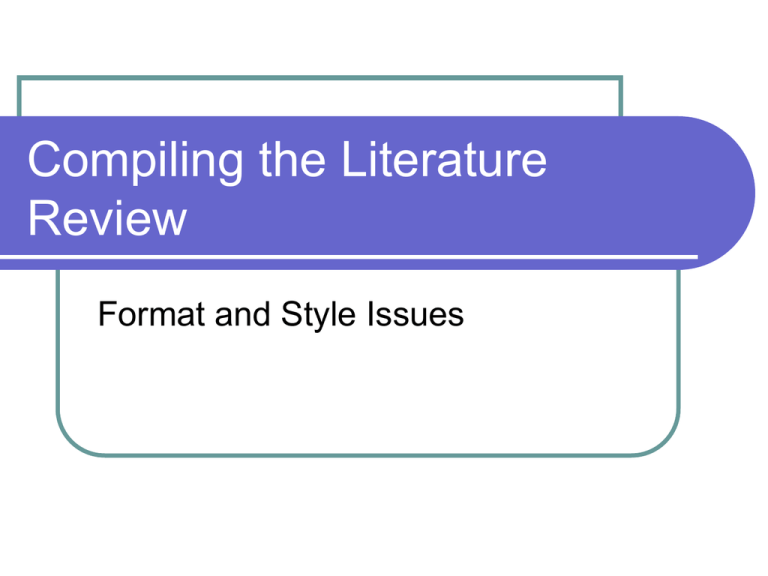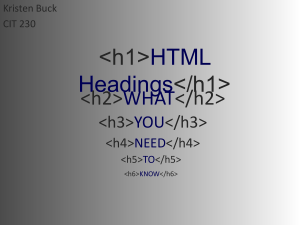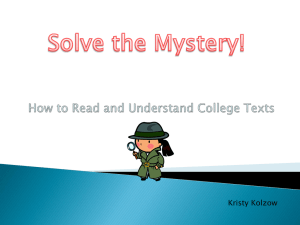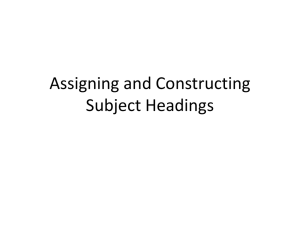Compiling the Literature Review ()
advertisement

Compiling the Literature Review Format and Style Issues The Introduction Create a one- to two-sentence introduction that serves as a forecasting statement and answers these questions: What is this section of the recommendation report? What will it cover – what issues will it address? List the subtopics in the order they will appear in the report. Sample Forecasting Statement This review of recently published literature on teamwork addresses organizational structure, group dynamics, team formation, and supervisor issues. Why Use Headings? Headings are an important feature of professional writing: headings alert readers to upcoming topics and subtopics, help readers find their way around in long reports and skip what they are not interested in, and break up long stretches of straight text. Headings Use headings to mark off the boundaries of the major sections and subsections of a report. Use the same spacing (vertical and horizontal location), capitalization, punctuation, and underlining. Make the phrasing of headings parallel. Parallelism Parallelism refers to the way that items in a series are worded. Use the same style of wording in a series of items--it makes it easier on the reader. Widely varied wording is distracting and potentially confusing to readers. Strategies for Effective Headings Make the phrasing of headings selfexplanatory: instead of "Background," make it more specific, such as “Turnover Statistics at Store #37." Make headings indicate the range of topic coverage in the section. For example, if the section covers the design and operation of a training strategy, the heading “Designing a Training Strategy" would be incomplete and misleading. Avoid "stacked" headings -- any two consecutive headings without intervening text. More Strategies Avoid pronoun reference to headings. For example, after a thirdlevel heading “Employee Training," don't begin the sentence following it with something like this: "This is an important principle....." When possible, omit articles from the beginning of headings. For example, "The Major Types of Shoplifting Deterrents" can easily be changed to "Major Types of Shoplifting Deterrents" or, better yet, "Shoplifting Deterrents." Don't use headings as lead-ins to lists or as figure titles. Avoid "widowed" headings: that's where a heading occurs at the bottom of a page and the text it introduces start at the top of the next page. Keep at least two lines of body text with the heading, or force it to start the new page. Fundamental Principle of Heading Design Decrease the “noticeability” of headings; the lower the heading level, the less it stands out. Make the top-level heading (called first-level) the largest, darkest, boldest, most highly visible heading on the page. To achieve this greater or lesser degree of visibility, use bold, italics, type size, or different fonts. Source: http://www.io.com/~hcexres/tcm1603/acchtml/headings.html Support from the Text See pages 573 and 578 – 579, which gives you guidelines for up to five levels of heading. It also provides examples of how to format them. You will probably need no more than three levels in your recommendation report. Conclusion To end the literature review section of your team’s recommendation report, briefly present conclusions drawn about the literature on your topic. Overall, how would you describe the literature on your topic? Sample Conclusion Overall, the literature on teams presents many important factors to consider when creating teams. Most authors agree that training is essential in areas such as communication and feedback, mutual accountability, and goal setting. Supervisors can contribute experience and guidance to the teams as they are formed and begin engaging in group dynamics. Other Issues to Consider Help each other make final corrections. Make sure that The APA is correct There is no overlap among the content of the sections The sections are as balanced as possible The style and approach are as consistent as possible The References Page Save your annotated bibliography with a new name. Delete the annotations. Delete any sources you did not cite in your lit review. Add any new sources. Make sure the in-text citations match up with the entries on the references page. Don’t forget…. Save your lit review and your references page on your team’s Group Space!










